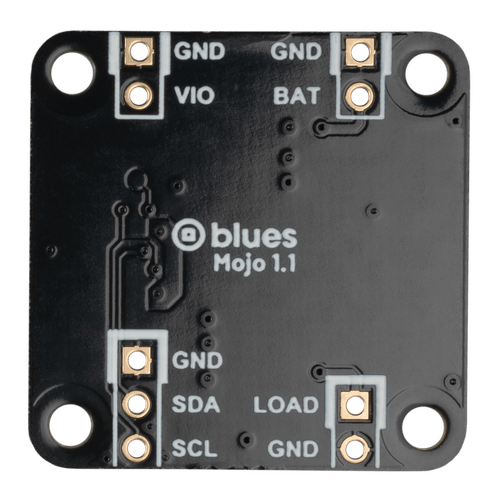Blues Mojo™ Datasheet
Functional Description
Mojo (short for “More Joules”) is a small, inexpensive Notecard companion device that measures energy usage in a battery-powered system. Inspired by the Joulescope and powered by a low-power coulomb counter, Mojo is designed to give product builders an inexpensive way of measuring the performance, charge, and state of deployed applications intended to operate on battery power over long periods of time.
Mojo is intended to be used with the Notecard, and includes two Qwiic connectors for wiring the board to a Notecarrier or for daisy-chaining multiple Qwiic peripherals together.
 note
note-
Mojo is supported on all Notecard Cellular, Notecard Cell+WiFi and Notecard WiFi models. However, Mojo does not currently work with Notecard for LoRa.
-
Mojo also works on all Notecarriers, but when used with a Notecarrier F the Feather must stay plugged in and awake, since QWIIC is powered from the Feather's 3.3V rail. Putting the Feather to sleep will cut power to QWIIC and when power is re-applied, Mojo will be in an unknown/unitialized state.
The Mojo hosts a LTC2959 coulomb counter from Analog Devices. The LTC2959 measures voltage, current, and charge accuracy to within 1% accuracy. The Mojo board includes two JST connectors for connecting the battery in and out to a load like a Notecarrier.


Features
- IC: LTC2959 coulomb counter from Analog Devices. Accepts 1.8V-60V.
- Connectors: 2x JST Battery Connectors PH-2POS wired for Adafruit-style packs and 2x Qwiic connectors.
- Header Pins: All connectors are also exposed via through-hole mounting pins.
- Notecard Compatibility: Mojo is automatically detected by the Notecard (firmware v8 and later), when connected via a Notecarrier using the Qwiic connector (
I2C). - Open Source Design: Design files for Mojo can be found in the note-hardware repository.
Power Information
The Mojo can be powered via its Qwiic connector or via the adjacent header pins
(VIO and GND) at 3.3V. The Qwiic connectors, also on the adjacent header
pins (SDA/SCL), supports 3.3V.
The LTC2959 measures voltage (1.8V-60V), current, and charge to within 1% accuracy. Rsense is 250mΩ. During operation, the LTC2959 draws less than 1.0µA.
 warning
warningWhen using Mojo with a Notecarrier F the Feather must stay plugged in and awake, since QWIIC is powered from the Feather's 3.3V rail. Putting the Feather to sleep will cut power to QWIIC and when power is re-applied, Mojo will be in an unknown/unitialized state.
Dimensions
The Mojo was designed with a minimal footprint for easy embedding in existing applications.
- 25.4mm (1.00 inches) wide
- 25.4mm (1.00 inches) deep
- 7.2mm (0.28 inches) tall
Header Pins
The Mojo features four sets of header pins, labeled as follows:
- J1 headers (next to
BAT): Left side of the Mojo,GNDandBAT. Right side isGNDandVIO. - J4 headers (next to
LOAD): Left side of the Mojo,GNDandLOAD. Right side isGND,SDA, andSCL.
Design Files
Open source hardware designs for the Mojo and all Blues Hardware are maintained in the note-hardware GitHub repository, including:
